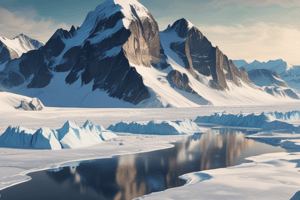Podcast
Questions and Answers
What is the primary factor that contributes to the formation of ice sheets in polar regions?
What is the primary factor that contributes to the formation of ice sheets in polar regions?
Low levels of solar radiation reaching the Earth's polar regions
What is the characteristic shape of the valleys where alpine glaciers are formed?
What is the characteristic shape of the valleys where alpine glaciers are formed?
V-shaped
What is the process by which snow becomes dense ice in the formation of glaciers?
What is the process by which snow becomes dense ice in the formation of glaciers?
Compaction by its own weight
What is the term for the zone where more ice is gained than lost over a year in a glacier?
What is the term for the zone where more ice is gained than lost over a year in a glacier?
What is the term for the floating sheet of ice that is permanently attached to a land mass and is sustained by ice from the mainland and freezing sea water?
What is the term for the floating sheet of ice that is permanently attached to a land mass and is sustained by ice from the mainland and freezing sea water?
What is the primary mechanism by which glaciers move?
What is the primary mechanism by which glaciers move?
What is the primary factor that determines the direction of glacial flow, and how does it affect the accumulation of ice?
What is the primary factor that determines the direction of glacial flow, and how does it affect the accumulation of ice?
Distinguish between the Zone of Ablation and the Zone of Accumulation, and explain how they impact the size of a glacier.
Distinguish between the Zone of Ablation and the Zone of Accumulation, and explain how they impact the size of a glacier.
What is glacial ice, and how does it differ from regular ice?
What is glacial ice, and how does it differ from regular ice?
What is the role of plucking in the formation of glacial landforms, and how does it relate to freeze-thaw weathering?
What is the role of plucking in the formation of glacial landforms, and how does it relate to freeze-thaw weathering?
What is the difference between erosion and weathering, and how do they contribute to the formation of glacial landforms?
What is the difference between erosion and weathering, and how do they contribute to the formation of glacial landforms?
What is the significance of moraine in the context of glacial landforms, and how do crevasses form?
What is the significance of moraine in the context of glacial landforms, and how do crevasses form?
Study Notes
Glacier Formation and Types
- Alpine glaciers form in mountainous regions, often joining together with other glaciers
- They are formed in V-shaped valleys, which were previously occupied by streams
- Alpine glaciers can range from 1 km to over 100 km in length
- Ice sheets, on the other hand, develop in polar regions due to low solar radiation, covering about 10% of the Earth's land area
- Ice sheets are thickest near the center and flow outward in all directions
Ice Shelves and Glaciers
- Where ice flows over ocean water, ice shelves are formed
- Ice shelves are floating sheets of ice permanently attached to a land mass
- Shelves become thinner seaward and often break off, forming icebergs
- Ice shelves are sustained by ice from the mainland and freezing seawater from below
Glacier Movement and Formation
- Glaciers form in upland and polar regions where it frequently snows
- Accumulated snow sets and becomes dense ice over time due to its own weight
- The bottom layer of ice melts due to pressure and gravity, causing the glacier to flow downwards
- This flow is driven by the glacier's own weight and gravity
Zones of Accumulation and Ablation
- The zone of accumulation is where snow is compressed into ice over a long period
- Where more ice is gained than lost over a year, it is called the zone of accumulation
- If accumulation exceeds melting, the glacier advances
- The zone of ablation is where more ice is lost than gained, causing the glacier to retreat
Glacial Ice and Flow
- Glacial ice is composed of interlocking crystals of solid H2O, forming once the ice and snow's thickness reaches 50 m
- Glacial ice has a definite internal structure, but its external structure may vary
- Glacial flow can be smooth and continuous, but surges can occur, with rates up to 100 times the normal flow rate
Glacier Parts and Features
- The snout is the end of a glacier
- Moraine (or glacial till) is the residue left behind after summer melting
- Meltwater is the water that flows downslope from melting ice, feeding rivers or lakes
- Crevasses are cracks in the snow or ice that can be dangerous for climbers
- Striations are long grooves or scratches created as ice flows over bedrock
Formation of Glacial Landforms
- Glaciers erode the landscape by picking up materials as they move
- Freeze-thaw weathering occurs when meltwater seeps into rocks, causing them to loosen
- Plucking occurs when the glacier plucks rocks from the landscape as it moves
- Abrasion occurs when rocks and stones in the glacier scrape against each other and the surrounding landscape
- Deposition occurs when the glacier deposits rocks and stones at the snout, forming moraines
Studying That Suits You
Use AI to generate personalized quizzes and flashcards to suit your learning preferences.
Description
Test your knowledge about the formation of alpine glaciers and ice sheets, their characteristics, and their effects on the environment. Learn about the different types of glaciers, their locations, and their role in shaping the Earth's surface. Get ready to explore the icy world!




